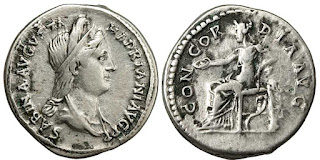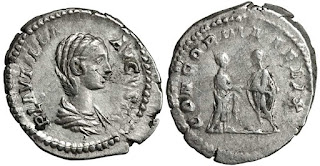Ancient coins show many interesting features, among the being what hairstyles were current when the coins were struck. Sometimes, these are formal styles deemed appropriate for the upper classes. Such styles demonstrated an adherence to tradition, and a steady approach. Some of the younger women are shown with very fashionable styles. Some examples seem designed to indicate a modest demeanor rather than represent reality. But these are far outweighed by hugely formal or outrageous fashionable concoctions.
Denarius of Crispina, 178-182 AD, Rome mint, silver, weight 2.4 gm
Coins that show mythical figures or personifications show a different approach. Here, the styles might be hundreds of years old, or be types allied to a particular deity.
Let's take a look at the different hairstyles across 700 years of history. Starting with three older Greek coins
Aphrodite, with her hair in a bag. This bag called a saccos, could then be bound with a cord in various ways. The nearest to this you see these days is a big, knitted cap worn by some. Bronze, Carthage, late 3rd century BC, weight 5.3 gm, Obverse: Head of Tanit left with wreath of grain ears, Reverse: Horse's head right, Punic letter O to the right
A Maenad with bunches of grapes in her hair, indicating her association with wild drunken frenzies, though she looks pretty calm. Her hair is wild on top, but rolled down the edges, which must be to hold in the fruit. It is more of a mythological symbol.
Silver, Triobol of Amphipolis from the reign of Philip V of Macedonia, 196-168 BC, weight 1.6 gm, Obverse: Head of Maenad right, wreathed in vine leaves and grapes, Reverse: Stern of galley, travelling left MAKE above.
Tanith from Carthage, a grain goddess whose hair is rolled around the brow and ear line, and who has some stalks of wheat tucked into it. Quite achievable as a style.
Silver Drachm of Corinth, 350-306 BC, weight 2.1 gm, Obverse: Pegasus flying left, Reverse: Head of Aphrodite left with hair bound in a sakkos.
Denarius of L.Valerius, Roman Republic 108-107 BC, Rome mint, silver, weight 3.8 gm, Obverse: winged draped bust of Victory right, XVI monogram below chin, Reverse: LVALERI/ FLACCI Mars walking left carrying spear and trophy, Apex before, corn behind.
These styles are on Roman Republican coins. Victory and Diana, the huntress have their hair pulled back and tied in a knot at the back of the head, a ''Psyche knot''. It's a Greek style which was two or three hundred years old when these coins were struck and would have been regarded as ''classical'' even then. The simple version of the knot must have been a very utilitarian style, easy to manage, not likely to get in the way of vigorous activity. These days, women use a similar style too.
Silver denarius of C. Postumius TA, Roman Republic, 74 BC, weight 4 gm, Obverse: draped bust of Diana right, bow and quiver over shoulder, Reverse: CPOSTVMITA, Hound running right, spear below.
Silver denarius of Mn Acilius Glabrio, Roman Republic, 49 BC, weight 3.6 gm, Obverse: SALVTIS Laureate head of Salus right wearing cruciform earring and necklace, Reverse: III VIR VALETV MNACILIVS Valetudo standing left holding snake and leaning on a column.
The way the hair is rolled around the sides of the head makes it easy to support decorations like the wreath.
Silver denarius of Sabina, 128-136 AD, weight 3.1 gm, Obverse: SABINA AVGVSTA HADRIANI AVG P P Diademed and draped bust right, hair in a plait down her neck, Reverse: CONCORDIA AVG Concordia seated left, holding out a patera in her right hand, left arm resting on a statuette of Spes which forms part of her throne. One cornucopia beneath the throne.
Silver denarius of Faustina Junior, 147-176 AD, weight 3.3 gm, Obverse: FAVSTINA AVGVSTA Draped bust right pearl band in hair, Reverse: IVNONI REGINAE Juno standing left, tall scepter in left hand, patera in righthand feeding a peacock at her feet left.
When Antoninus Pius' wife Faustina died, he issued millions of coins in her honor. They all had this ornate hairstyle, with the hair plaited and brought back up the head, coiled and knotted, and it looks as though there were pearls strung through it. Her daughter, Faustina Junior, wore a simpler style with the hair waved and drawn into a bun at the back, sometimes with a pearl diadem that is seen on the coin. The bun was sometimes plain, sometimes decorated, small or large, but always there. All Faustina coins can be recognized by the hair style.
Silver denarius of Diva Faustina Senior 139-141 AD, weight 3 gm, Obverse: DIVA FAVSTINA Draped bust right with pearls in hair, Reverse: C-E-RES Ceres, veiled standing left, long torch in left hand, two ears of corn in her right hand.
Silver denarius of Lucilla 164-169 AD, weight 2.9 gm, Obverse: LVCILLA AVGVSTA Draped bust right, waved hair leading to a plaited bun. Reverse: PVDIC-ITIA Pudicitia seated left, right hand on breast, left hand down by side.
Lucilla was the daughter of Faustina Junior. Like the other young women of this era, her coins had a variety of hair styles.
Silver denarius of Crispina, 178-182 AD, weight 2.4gm, Obverse: CRISPINA AVGVSTA Draped bust right, Reverse: HIL-A-RITAS Hilarities standing left, holding palm and cornucopia.
Crispina was Commodus' wife. Her style with her hair plaited and woven on the head, then bought into a bun, was also worn by Faustina Junior, later in life.
Silver denarius of Plautilla, 202-205 AD, weight 3.4 gm, Obverse: PLAVTILLA AVGVSTA Draped bust right, corn rows doubled up at nape, Reverse: CONCORDIA FELIX Caracalla standing right, clasping right hands
Plautilla was the wife of Caracalla, son of Septimius Severus and inheritor of the empire. Her coins showed quite a range of hairstyles.
Silver denarius of Julia Domna, 194-218 AD, weight 2.7 gm, Obverse: IVLIA AVGVSTA Draped bust right, Reverse: SAECVLI FELICITAS Isis standing right, left foot on prow, the infant Horus held, right hand holding a small wreath, rudder resting against the stern of a vessel behind.
Julia Domna was the Syrian wife of the emperor Septimius Severus. Her early hairstyle was an elongated bun at the back, with two waved wings of hair drawn down on either side of her head. Her older sister Juia Maesa's hair was similar, but much more gently waved than Domna's severe corrugations.
Silver denarius of Julia Maesa 218- 225 AD, weight 2.6 gm, Obverse: IVLIA MAESA AVG Draped bust right, Reverse: PVDICITIA seated left, left elbow resting on arm of chair and holding scepter, right hand pulling out veil from shoulder.
Silver denarius of Julia Mamaea, 222-235 AD, weight 2.6 gm, Obverse; IVLIA MA-MAEA AVG Diademed draped bust right, Reverse: FELICI-T-AS PVBLICA Felicitas standing facing head left, legs crossed holding a short caduceus in right hand and leaning left elbow on column.
Julia Mamaea, Maesa's daughter, had the strongly emphasized waves favored by her aunt Domna, but kept the reduced bun and the clips at the nape.
Billon, antoninianus of Salonina 253-268 AD, weight 4 gm, Obverse: SALONINA AVG Diademed draped bust right, resting on crescent. Hair weaved in rows with long plait carried up the back of the head and tucked under a stephane, Reverse: SALVS AVG Salus standing right holding a patera in her left hand to feed a snake held in her right arm.
Otacilia Severa, wife of Philip I, and Salonina, wife of Gallienus, both had this style on their coins. The plaiting of the hair is very clear.
Billon, antoninianus of Severina, 270-275 AD, weight 3.1 gm, Obverse: SEVERINAE AVG Diademed and draped bust right, a crescent behind her shoulders, Reverse: CONCORDIAE MILITVM Concordia Militum standing facing, head left, holding a military standard in each arm.
Severina was married to one of the strongest military emperors, Aurelian. The idea of bringing the hair back of the head was kept, even though it wasn't in a plait. It reached right to her forehead before coiling back. Helena, the first wife of Constantius Chlorus, had a much simpler style that would not look out of place today.
Billon of Helena, Augusta, 324-380 AD, weight 1.6 gm, Obverse: FL IVL HE-LENAE AVG Diademed bust right, wearing a necklace, Reverse: PAX PV-B-LICA Pax standing left holding branch downwards in right hand, transverse scepter in left hand.
Bronze follis of Fausta, 326 AD, weight 2.5 gm, Obverse: FLAV MAX FAVSTA AVG Mantled bust right, bare headed, waved hair drawn into a bun at the back, Reverse: SALVS REI-PVBLICAE Fausta standing facing, head left holding Constantine II and Constantius II as babies
Fausta, wife of Constantine the Great, looks different. She is wearing the traditional strongly waved hair, lifted off the nape into a larger and more ornate clasp. Theodora, second wife of Constantius Chlorus, had the loop of hair at the nape, but wore a diadem round her head instead of bringing the plait further up.
Billon of Theodora, Augusta, 337-340 AD, weight 1.7 gm, Obverse: FL MAX THEO-DORAE AVG Draped bust right with braids, circling her head, Reverse: ROMANA Pietas standing facing, head right, holding child in her arms.
Different hair styles remained engraved on coins till about 400 AD. After this, coins of the Roman and Byzantine empires are not very informative about hairstyles.






















No comments:
Post a Comment
Any inputs or feedback is welcome!